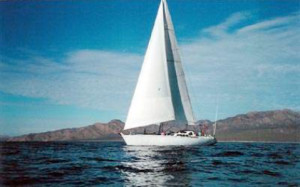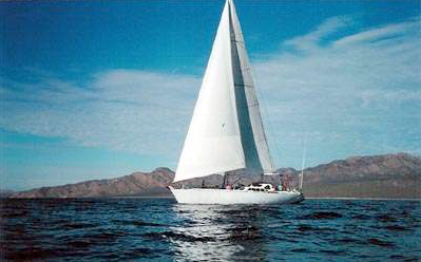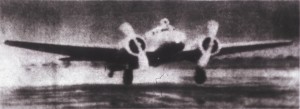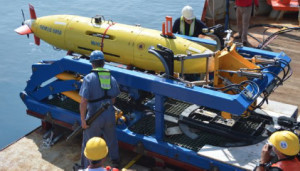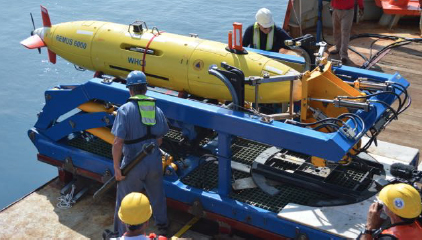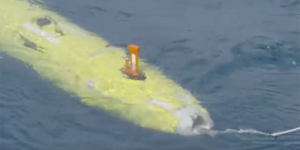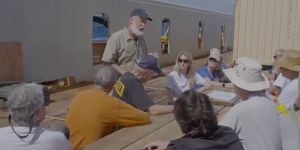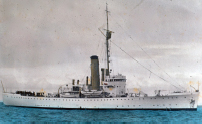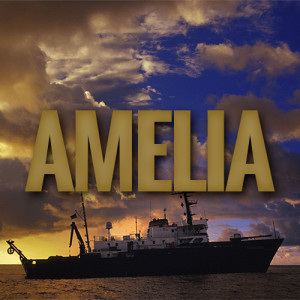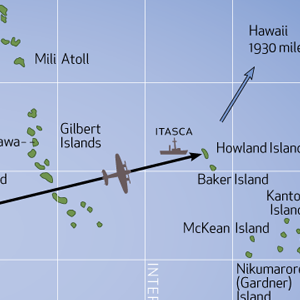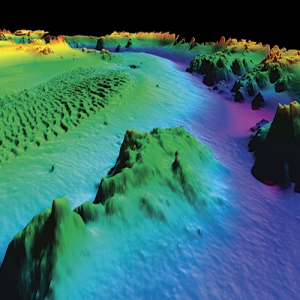Central Pacific Edition
Opening Night
Mermaid Vigilance Arrives in Operations Area
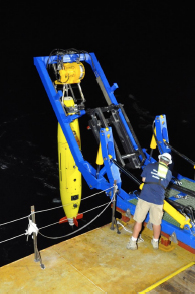 Our week-long transit has brought us to a featureless spot in the remote Pacific where the Amelia Earhart search will finally resume. Last night at around 2000 local time Mermaid Vigilance reached our first transponder deployment point, and a baseline of two beacons was dropped. We spent the next two hours surveying the
Our week-long transit has brought us to a featureless spot in the remote Pacific where the Amelia Earhart search will finally resume. Last night at around 2000 local time Mermaid Vigilance reached our first transponder deployment point, and a baseline of two beacons was dropped. We spent the next two hours surveying the
baseline, then the REMUS AUV was lowered off the stern. A smooth night launch was followed by hours of waiting as the AUV dropped to the bottom more than 18,000 feet below and began its assigned search pattern.
The REMUS OPS team was pleased with the event, and are certainly happy to be able to start collecting data. Many slow, long hours will follow as we patiently track the vehicle’s progress and await completion of the pattern.
The AUV is expected to surface late afternoon, scheduled to ensure our first recovery since sea trials a week ago will take place in daylight hours. Meanwhile, we will plan to lay and survey additional transponders and continue to add to the search pattern. As soon as REMUS returns and is safely lodged in its cradle the “pit stop” will begin. Data download will commence, batteries will be swapped, and the vehicle will be prepared for another launch.
Down to Rockland Way
A Cap’n Joe Sea Story
While a fishin’ outa Portland on the ol’ Eastern rigged draggah MustHe (not her real name, it’s just what we called her — her registered name on her State-o-Maine paper is Why Must He Suffer) we’d often steam down the coast aways to work the channel between Maine and Nova Scotia, a disputed borderline at the time but generally reliable for fair to middlin’ fishin’ on black-backed floundahs. Well we had a breakdown — not unusual on the ol’ MustHe — and was forced to veer off into Rockland t’ fetch a part and get her fixed up some.
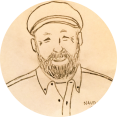 Young Manley Doherty was the skipper and a very able (if somewhat excitable) fisherman. I was deckhand/cook. Enoch Johnson sailed as the engineer, of sorts, and Old Man Manley (yes, Young Manley’s pa) was aboard as the twine man. He was my mentor and a highly respected net guy up and down the whole New England coast. He was simply the best. But like a lot of fellas in the fish biz Ol’ Manley tended, on occasion, to over indulge in the demon rum and thus generally didn’t have many long term berths. So that’s how he ended up aboard the ol’ brokendown MustHe with his son. Old Man Manley called Young Manley “Boy.”
Young Manley Doherty was the skipper and a very able (if somewhat excitable) fisherman. I was deckhand/cook. Enoch Johnson sailed as the engineer, of sorts, and Old Man Manley (yes, Young Manley’s pa) was aboard as the twine man. He was my mentor and a highly respected net guy up and down the whole New England coast. He was simply the best. But like a lot of fellas in the fish biz Ol’ Manley tended, on occasion, to over indulge in the demon rum and thus generally didn’t have many long term berths. So that’s how he ended up aboard the ol’ brokendown MustHe with his son. Old Man Manley called Young Manley “Boy.”
We rounded the Rockland Harbor sea jetty at about 0900 and shortly after were made all fast at Frank O’Hara’s fish dock. We all had our chores: Capt’n Manley was going to head to the Greyhound Bus Station to get the needed condenser part that his wife, Miss Betsy, was sending up from Portland (Manley had called her via the marine radio operator). Enoch was going to see if he could scrounge up some oil diapers and a few extra rags. I was going to the store to buy some more salt pork. I thought I had enough but wasn’t going to take any chances as this is used in about ninety-two and a half percent of my fixin’s. And, on very direct orders to Old Man Manley, Young Capt’n Manley said:
“Pa, you stay aboard. Work on that cod-end, it needs some seizing re-done. Don’t leave now for any reason. We’ll all be back by noon and we’re shoving off then so you stay aboard, ya hear?”
Well you can kinda guess what happened next: We all returned shortly after 1100 and Old Man Manley was not to be seen. We did a search of the MustHe, and she being just shy of seventy-two feet of wooden fish boat the search didn’t take all that long. Young Manley was up the ladder two rungs at a time and just a cursin’ a somethin’ fierce all the while as he was headin’ right two-blocked to the Hotel Bar (it opens at 0600 to accommodate the local tradesmen) to fetch his Pa. But Old Man Manley t’weren’t there neither! Back to the MustHe comes Young Manley still a cursin’ up a gale-o-breeze but not quite as loud as before having got a bit winded on the roundtrip, I suspect. Soon as Young Manley is back aboard he goes into his captain’s mode: “Fire her up, Enoch, we’re outa here, ta hell with that damn ol’ man anyway!”
Legends are born like this: We cast off from Frank’s fish dock and headed outbound past the Rockland Harbor sea jetty. Enock Willard and I were getting a mugup in the galley. Just as we rounded the jetty Old Man Manley comes in through the hatch, soaking wet, and says: “Damn! I wish you fellas had backed her off a might, I had a hell of a time catching you!” I think at the sight of the Old Man, Enoch keeled over and I was taken some hard astern myself. I finally managed to stammer: “Manley you mean to say that you jumped off that quay and swum aft’a us and hauled yerself aboard?” And Ol’ Manley smiled at us and says: “Aya, I’s here ain’t I?”
This story spread down the coast quicker than a dungeon-blue–thick o’ fog on an easterly breeze.


